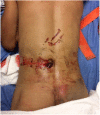Direct withdrawal of a knife in the lumbar spinal canal in a patient without neurological deficit: case report and review of the literature
- PMID: 29928514
- PMCID: PMC5999647
- DOI: 10.1038/s41394-018-0086-3
Direct withdrawal of a knife in the lumbar spinal canal in a patient without neurological deficit: case report and review of the literature
Abstract
Introduction: Stab-wound injuries to the spinal cord are rare and currently, do not have a well-established management in the literature despite its strong association with neurological injury.
Case presentation: We report a case of a patient with a stab-wound injury with a knife in the lumbar region, who underwent direct removal in the operating room without surgical exploration. Upon admission, the patient had no neurological deficit. The X-rays and CT scan before removal showed the involvement of >50% of the intramedullary canal at L2. The removal was performed in the operating room with a surgical team available and ready in case there was neurological deterioration during the procedure.
Discussion: We concluded that any neurologic deficit in a patient with a stab-wound injury in the spine must mandate surgical exploration and in patients without neurological deficit, direct removal of the stabbing object is a safe and effective method without adding the risks of a surgical exploration.
Conflict of interest statement
Compliance with ethical standardsAll the authors declare that they have no conflict of interest.*The patient was asked for his written consent for the publication of his clinical case, mentioning that no personal information will be revealed.
Figures
References
-
- Spinal cord injury facts and figures at a glance. National Spinal Cord Injury Statistical Center. https://www.nscisc.uab.edu/. Accessed 09 Jul 2014.
-
- Peacock WJ, Shrosbree RD, Key AG. A review of 450 stab wounds of the spinal cord. S Afr Med J. 1977;51:961–4. - PubMed
-
- Doğan S, Kocaeli H, Taşkapilioğlu MO, Bekar A. Stab injury of the thoracic spinal cord: case report. Turk Neurosurg. 2008;18:298–301. - PubMed
LinkOut - more resources
Full Text Sources
Other Literature Sources





